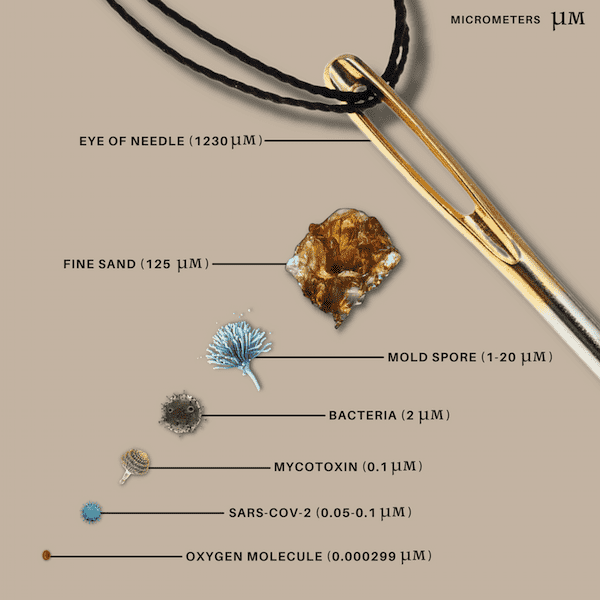We’ve all been exhausted at one point or another. Life can get seriously overwhelming sometimes, between work, chores, family time, errands, and whatever else pops up on our calendars. With all of the stressors in life, symptoms such as chronic fatigue can often fall through the cracks and get blamed on the stress that is life. There are a million reasons to be tired! When that fatigue turns into exhaustion so intense that your daily life starts being affected, that’s typically when overlooking this symptom stops. Questions then start being asked, such as whether or not mold exposure and Chronic Fatigue Syndrome could be to blame.

But wait, are those two topics even related? While Chronic Fatigue Syndrome has been an area of research for 34 years, the underlying cause of the condition has yet to be identified. That being said, recent studies point to a relationship between mold exposure and Chronic Fatigue Syndrome.
The issue is that mold, in general, remains a little-discussed and under-researched indoor contaminant. Many individuals living in a moldy environment have no idea the contaminant is even in the home or that it could be causing their chronic health conditions. The unfortunate reality is that until the environmental trigger is discovered and removed, those symptoms will persist, if not get even worse.
To make the situation even more difficult, research and awareness regarding Chronic Fatigue Syndrome also have quite a long way to go.
Understanding the budding research pointing to a relationship between mold exposure and Chronic Fatigue Syndrome helps shine a light on the importance of looking to our indoor environments for possible diagnoses. As we spend the majority of our day inside, what’s in that space matters.
Part One: Chronic Fatigue Syndrome
At its basic level, fatigue is a continuous state of exhaustion that slowly chips away at concentration, motivation, and mental health.¹ With the busy state of the world nowadays, this state of being could happen to anyone at multiple times in life. However, when this condition cannot be resolved with extensive rest, that’s when it moves into the territory of Chronic Fatigue Syndrome.
Chronic Fatigue Syndrome, or Myalgic encephalomyelitis, is defined as fatigue that “worsens with physical or mental activity, but doesn't improve with rest.” ² The effects of exhaustion are so severe that even daily tasks become difficult to accomplish. Running errands or making dinner can lead to an overwhelming need to return to bed, rest, and attempt to recuperate.
Except, with CFS, that recharge time never occurs and internal energy levels remain at that low base level. Eventually, this ongoing exhaustion can lead to work, relationship, and overall life burnout. At least one in four ME/CFS patients is bed- or house-bound for long periods during their illness.³
Researchers hypothesize that around 2.5 million Americans suffer from CFS, and about 90 percent of those suffering from the condition have not been diagnosed. That sparks the question as to why so many are continuing to unknowingly suffer.

The Cause of Chronic Fatigue Syndrome
Chronic Fatigue Syndrome has officially been on the medical world’s radar since 1988 after researchers examined sick individuals during the epidemic at Lake Tahoe, Nevada.⁴ Still, while it’s been over three decades since the official name for the condition was coined, researchers still aren’t sure as to what exactly causes this chronic illness.
A few potential options currently being considered are infections, immune system issues, hormonal imbalances, and trauma. Still, nothing concrete points to the main cause. As for environmental triggers, few have been considered as possible culprits for triggering this condition, making the relationship between mold exposure and Chronic Fatigue Syndrome that much more interesting.
The lack of an underlying trigger makes CFS incredibly difficult to diagnose. No test exists (yet) that can 100% identify the condition. To pinpoint whether or not CFS is at play, a doctor must rule out any other potential conditions such as mononucleosis, Lyme disease, and depression. Essentially, it’s a disease of exclusion. If the chronic symptoms can’t be diagnosed as anything else, it just may be CFS.
Once all of the other potential causes are ruled out, treatment for the condition can begin.
Treatment for Chronic Fatigue Syndrome
Without identifying an underlying cause, treatment for this condition is tough to achieve. Managing the symptoms is essentially the overall goal when it comes to providing relief from CFS. Typically, the healthcare professional will work with the patient to determine which symptoms are the most difficult to handle and create a plan to alleviate them.⁵

For example, for someone suffering from depression related to CFS, a doctor may prescribe antidepressants and therapy to help mitigate symptoms. If they experience chronic pain, over-the-counter or prescription-strength pain relievers may be prescribed to help ease the inflammation. Creating better sleeping habits, activity management (pacing), and memory aids may also be advised. At the end of the day, though, treatment for this condition is essentially all about coping. There is no “cure” for CFS.
Still, not all treatment plans work. Sometimes, no matter what steps are taken, the chronic symptoms just will not go away.
This opens the door for questions such as whether or not CFS is to blame or if there are environmental factors to play. This potential relationship and the confusion between the conditions are why it’s important to understand mold exposure and Chronic Fatigue Syndrome. Otherwise, misdiagnoses could be made and symptoms allowed to persist.
Part Two: Mold
Before getting into mold exposure, it’s best to know what exactly mold is and how it can cause problems.
What is Mold?
There are over 100,000 species of mold identified so far, and they exist all over the world. While they’re categorized into three groups: allergenic, pathogenic, and toxic, the truth is that any mold can have the potential to cause health issues. Here’s why.
As mold colonies grow, they release microscopic spores into the air.⁶’⁷ Some species of mold also produce microscopic toxins called mycotoxins when they feel threatened.⁸ While these toxins are regulated in food, there are currently no regulations for acceptable levels of mycotoxins in the home.¹⁰ To make matters even more contaminated, depending on the source of the water event that led to the moldy situation, bacteria may be present as well.
Particle size matters here. With mold spores ranging from 1-20 microns and mycotoxins coming in at around 0.1 microns, they’re seriously small particles. A single micron is one-millionth of a meter. For a better perspective, lining up 1,000 microns equals the distance between two of those tiny lines on a ruler.
These particles are so minuscule that they’re further categorized as particulate matter. The EPA groups particulate matter into two groups, both of which are inhalable.¹¹
These categories are:
- PM₁₀: particles with diameters of 10 micrometers (microns) or less
- PM₂.₅: fine particles with diameters of 2.5 micrometers or less

The key thing to note is that both spores, mycotoxins, and bacteria are inhalable and ingestible, making them serious environmental contaminants to be aware of as they can affect the health of those exposed.
Mold Exposure and Health
Like Chronic Fatigue Syndrome, the impact of mold exposure on health continues to be a topic of research. It’s a tricky subject to nail down. Factors such as genetics, immune system status, species of mold, presence of mycotoxins, and length of exposure all play a role.
Researchers do know that individuals with preexisting conditions, compromised immune systems, and developing immune systems are at greater risk when it comes to developing symptoms. ¹²’¹³’¹⁴’¹⁵’¹⁶’¹⁷ Genes can also contribute to someone feeling ill from mold exposure. ¹⁸ Those who carry the HLA-DR gene struggle to recover from mold and other toxin exposures. This specific gene inhibits the immune system from being able to recognize which cells belong in your body and which cells do not, allowing for foreign particles like mold spores and toxins to build up.
The tricky part is that, because of the factors listed above, no two experiences with exposure are the same. One person may develop just chronic fatigue and an occasional runny nose, while another may experience chronic fatigue and 17 other symptoms. And they could both be living in the same home.Mold exposure, in general, though, has the potential to cause symptoms. That’s reason enough for this indoor contaminant to be avoided.
The Impact of Indoor Mold Growth
When the body encounters a few mold particles, spores, or toxins throughout the day (which is unavoidable), it will activate the immune system to get rid of them. If the individual doesn’t have the HLA-DR gene, that is. As mentioned above, when this gene is present in the body, the immune system will not deploy and those toxins will automatically build up.

Typically, a few particles throughout a single day aren’t a problem. When mold grows within a home, though, the body isn’t facing down a few problematic particles; it’s confronting an entire army of them. As that mold colony grows, it continues to release spores (and sometimes mycotoxins) into that indoor environment. Those particles will float along with the indoor air current to wherever it leads, whether it's throughout the room where the mold colony is growing or to other areas of the house. They’ll also land on whatever surface they come into contact with.
An important factor to consider here as well is how homes are now constructed. Built with energy efficiency in mind, there’s very little airflow between the indoor and outdoor environments. That means that most of those particles remain within the home. It’s essentially like living in a particle-filled contamination bubble where you’re constantly breathing in contaminated air and touching contaminated surfaces.
While mycotoxins and some species of mold are naturally toxic and can trigger symptoms quickly, any species of mold has the potential to cause issues. A prolonged onslaught of that many foreign particles can cause the immune system to get overrun and potentially malfunction, resulting in a list of symptoms and related autoimmune conditions. While mold exposure and Chronic Fatigue Syndrome can work together, this fungus can also work in tandem with other conditions such as Lyme disease, Candida, and Epstein-Barr Virus.
Hence, why any and all indoor growth should be treated similarly: removed quickly and correctly to avoid issues such as mold exposure and Chronic Fatigue Syndrome.
How Could Mold Exposure and Chronic Fatigue Syndrome Be Related?
So far, a few studies have shown a causal relationship between mold exposure and Chronic Fatigue Syndrome.
These include:
- A 2019 study surveyed CFS patients where 39.4% reported that their symptoms of post-exertional malaise were triggered by mold exposure.¹⁹
- In another study, urine samples were analyzed from 112 CFS patients and 93% were positive for at least one mycotoxin (one in the equivocal range). Almost 30% of the cases had more than one mycotoxin present. Exposure histories indicated current and/or past exposure to water-damaged buildings in over 90% of cases.²⁰
Still, much more research needs to be done to dive deeper into the relationship between mold exposure and Chronic Fatigue Syndrome. The more we know, the more we can work on creating better treatment and immediately finding the source of the exposure so it can be eliminated. Otherwise, those symptoms will persist. Establishing a connection will also assist in highlighting the importance of considering environmental factors as the root causes of chronic illness. It’s a subject that’s rarely considered in today’s medical world.
Speaking of symptoms, comparing both mold exposure and Chronic Fatigue Syndrome shows how indistinguishable and intertwined these two things can be.

The Symptom Similarity
The main bridge between mold exposure and Chronic Fatigue Syndrome is ongoing fatigue, but other common symptoms also point to a relationship.
Chronic Fatigue Syndrome Symptoms Include:
- Chronic fatigue
- Mood shifts
- Muscle and joint pain
- Headaches
- Tender lymph nodes in the neck or armpits
- Sore throat
- Digestive issues
- Chills and night sweats
- Allergies and sensitivities to foods, odors, chemicals, light, or noise
- Muscle weakness
- Shortness of breath
- Irregular heartbeat
Mold Exposure Symptoms Include:
- Chronic fatigue
- Mood shifts
- Muscle and joint pain
- Headaches
- Tender lymph nodes in the neck or armpits
- Sore throat
- Digestive issues
- Chills and night sweats
- Allergies and sensitivities to foods, odors, chemicals, light, or noise
- Muscle weakness
- Shortness of breath
- Irregular heartbeat
Do they look similar? They should! Both can result in the exact same symptoms, showing how intertwined the two can be.
Still, chronic fatigue is at the heart of these illnesses, and it’s a great route in which the relationship between mold exposure and Chronic Fatigue Syndrome can be shown.
Mold And Fatigue
Mold can trigger fatigue in a variety of ways.²¹
One of the main reasons behind this feeling of debilitating exhaustion goes all the way back to high school and learning about the mitochondria, aka the powerhouse of the cell.²²’²³ When something gets in the way of the ability of the mitochondria to create energy, the body will experience fatigue. One thing that happens to throw a wrench in normal cellular energy action is mycotoxins, a toxic byproduct created by some species of mold. These microscopic toxins have been shown to disrupt the normal functioning of mitochondria.
Just imagine how much of an impact living in a mycotoxin-filled environment can have on those mitochondria.

Decreased oxygenation is another way that mold exposure can trigger fatigue, and it can occur in a variety of ways. ²⁴’²⁵
These include:
Respiratory problems like pneumonia can limit the amount of oxygen you can take in
- The white blood cells released to fight off mold particles reduce the amount of space for red blood cells, resulting in decreased blood flow and oxygen
- Mycotoxins can cause hemoglobin dysfunction, hindering its ability to operate properly
Finally, mycotoxins have been shown to cause neurotransmitter imbalances as they cross the blood-brain barrier.²⁶’²⁷’²⁸’²⁹ This imbalance results in lower dopamine levels, which have been linked to fatigue.
Why Understanding Mold Exposure and Chronic Fatigue Syndrome Matters
The information above is important for a variety of reasons. It’s no secret that environmental factors like mold and “tricky conditions” like CFS aren’t talked about as much as they should be. As a result, not nearly as many medical professionals are aware of them as they should be. This can lead to a lack of diagnosis or misdiagnosis for those experiencing chronic symptoms like fatigue.

In a nutshell, being aware and helping to create greater awareness of mold exposure and Chronic Fatigue Syndrome can help those suffering from ongoing symptoms find answers and relief faster. Especially when the two are working together to cause debilitating symptoms. Until the mold is remediated, those reactions will continue, regardless of any treatment attempted. The body is continually battling a legion of foreign particles, some of which might be naturally toxic.
No treatment in the world will solve an ongoing illness when the perpetrator is still right there every single day.
Far too many people have suffered and are continuing to suffer from a contaminated indoor environment simply because environmental factors are rarely considered in a diagnosis. As the average individual spends most of their time inside and breathes around 20,000 breaths a day, what’s in that space matters. An uncontaminated indoor space allows for healing and removes the option for exposure-related illnesses to pop up.
How to Handle Mold Exposure and Chronic Fatigue Syndrome
For anyone pondering whether or not mold exposure and Chronic Fatigue Syndrome may be the root cause of their illness, or if they know mold is the problem, the first step is to determine where the exposure is coming from. Think of the indoor spaces that are frequented the most, and then work up from there. As we spend most of our time in our homes, that’s the best place to start.
These are the steps to take to create a safe home environment. If mold isn’t in the home, start looking at other areas such as office spaces and vehicles.
Mold Inspection
These professionals are the first line of defense against a moldy, contaminated environment. Not all inspectors are created equal, though, so make sure to do your due diligence and be aware of what to expect.
Above all, the individual hired should understand how important their job is and that your health is on the line. Their job will be to paint a detailed picture of the status of the home that the remediation team will be able to use to decontaminate the indoor space. Don’t be afraid to ask them questions, such as prior experience and any limitations they may have
A proper inspection should then take a few hours and use a variety of methodologies.
Some of the testing data you should expect to see is:
- Species of mold present
- Quantities of each mold
- Potential spore presence in the HVAC system
- Presence of mycotoxins
- Presence of bacteria

Remediation
From there, the remediation team should be able to use this information to come up with a plan to properly remediate the home. Like mold inspectors, though, not all remediation companies are built the same. They should understand the impact of mold exposure and Chronic Fatigue Syndrome on health and how important it is to have a safe indoor environment.
That includes being able to remove other contaminants such as mycotoxins and bacteria, which are more difficult to remove than just mold. As shown earlier, mycotoxins can directly result in symptoms such as chronic fatigue. To avoid this, a remediation team should adhere to three pillars for success.
The three pillars of success are:
- Remediate the sources properly.
- Identify and address the problems that led to those sources in the first place.
- Eradicate all contamination created by those sources, including toxins and bacteria.
If any checkmark isn’t completed, the mold growth could come back or contamination could remain when the remediation team leaves. Either situation is a failed remediation and can result in those suffering from mold exposure and Chronic Fatigue Syndrome continuing to experience symptoms.
At the end of the day, when the team leaves the home, the space should no longer have the source that led to the mold and all contaminants should be removed.
Healing the Body
Once the indoor space is taken care of, detoxifying the body from all of the harmful particles will be next. First and foremost, the healing process should start in a clean and healthy space. If remediation can’t occur or is being held up, that means moving out is the best option. The body can't heal when it’s constantly being peppered by more and more contaminants.

From there, finding a doctor that understands mold exposure and Chronic Fatigue Syndrome and how to detox properly is key. Not all medical professionals are well-versed in environmental contaminants, so working with someone familiar with the process can help make sure that healing actually does occur. This individual should also be aware of how to work with the testing results received from the mold inspector to help determine exactly what’s going on inside the body and what steps need to be taken to get the body back in balance.
Keep in mind that healing from mold exposure takes time.
Those particles and toxins can remain trapped within the body and require dedication and patience to fully remove them. Just remember that healing is possible and that detox protocols aren’t one-size-fits-all. It can take a bit of trial and error to determine what fits each unique body best.
Maintaining a Safe Environment
After ticking off each box above, the final piece of the anti-moldy puzzle is to make sure that space stays safe. Not only that, for anyone simply concerned about experiencing the dual effects of mold exposure and Chronic Fatigue Syndrome, actively working to prevent fungal growth and maintaining an environment with minimal contamination is always a good move. The best way to handle mold is to prevent it from growing inside in the first place.
Prevention itself not only helps remove mold spores from an indoor environment, lowering the chances that they’ll stumble into a habitable environment, but it also helps remove the components needed for growth. Mold growth needs two main ingredients for life: food and water. Given these, a spore can transition into a mold colony in 24–48 hours. By eliminating these two things, any lucky spore that makes its way inside never gets a chance to grow.
Steps to prevent indoor mold growth include:
- Maintaining indoor humidity between 30-50%³⁰
- Creating airflow by turning on the exhaust fans
- Cracking a door or window while showering
- Deep cleaning regularly
- Maintain appliances such as the dishwasher, refrigerator, and washing machine
- Using a HEPA vacuum cleaner
- Investing in air purification
- Regularly inspecting moldy hotspots

- Servicing the HVAC
- Make sure the exhaust ducts don’t pump the moist air into the attic
- Fixing leaks immediately
- Keeping windows and doors closed on humid days
- Purchasing a dehumidifier if needed
- Inspect exterior windows and doors for any gaps from loose caulking or cracks
- Take a look at the grading around the outside of the home to make sure it’s not sloped towards the house
This list isn’t exhaustive, but it’s a great way to get started on a safe indoor environment. Don’t feel like you have to jump in with both feet, though. That can lead you to feel overwhelmed. Choose a few and work on accomplishing them before moving on to the next step.
A Healthy, Happy Home
With the lack of discussion in society about how our indoor spaces can impact our health, the relationship between mold exposure and Chronic Fatigue Syndrome may have never crossed your mind. That doesn’t mean they can’t work together to wreak havoc on our bodies, though! To live healthy lives, we’ve got to create and maintain an awareness of factors such as environmental contaminants. Otherwise, individuals could continue living with conditions like Chronic Fatigue Syndrome and never experience relief.
Eventually, this shift in mentality will occur. The more we talk about mold and related conditions like Chronic Fatigue Syndrome, the more we can work on helping people find relief. No one should continue to feel chronically ill because of the state of their indoor environment. Especially when that contamination triggering symptoms can be removed.
Make sure to always consider environmental factors when determining the root cause of symptoms. And! Make sure to focus on trying to find the root cause, not just relying on medication to alleviate the symptoms.
Health begins at home.™

Ready to Take Action?
Start with The Dust Test. Gravity brings particles like mold spores, mycotoxins, and endotoxins down to horizontal surfaces like floors, door frames, and furniture. So basically, where dust collects, so do these indoor contaminants.
Testing and analyzing this dust will help determine what’s hanging out in your home. If there are high levels of contamination, you can use the results as the foundation for the next steps of the process.
The data collected will create a roadmap for the inspector and give you the ability to say, "Please help me find where these contaminants are coming from." From there, the remediation team should have all the information needed to properly remove all of the sources of contamination in the home and ensure it’s a healthy space. It can also be used to corroborate with a medical professional to determine where exposure is occurring.
Pro tip: Even if you don’t suspect a current problem, it’s still a great idea to use the test annually to make sure your indoor environment is safe. Think of it like an annual checkup at the doctor, except it’s for your home.
- “Fatigue.” Mayo Clinic, Mayo Foundation for Medical Education and Research, 2 Dec. 2020, https://www.mayoclinic.org/symptoms/fatigue/basics/definition/sym-20050894.
- “Chronic Fatigue Syndrome.” Mayo Clinic, Mayo Foundation for Medical Education and Research, 24 Sept. 2020, https://www.mayoclinic.org/diseases-conditions/chronic-fatigue-syndrome/symptoms-causes/syc-20360490.
- “Treatment of ME/CFS.” Centers for Disease Control and Prevention, Centers for Disease Control and Prevention, 28 Jan. 2021, https://www.cdc.gov/me-cfs/treatment/index.html.
- Clayton, E. W. (2015). Beyond myalgic encephalomyelitis/chronic fatigue syndrome: an IOM report on redefining an illness. Jama, 313(11), 1101-1102.
- “Myalgic Encephalomyelitis or Chronic Fatigue Syndrome (ME/CFS).” NHS Choices, NHS, 28 Oct. 2021, https://www.nhs.uk/conditions/chronic-fatigue-syndrome-cfs/treatment/.
- Environmental Protection Agency. (n.d.). Mold. EPA. Retrieved from https://www.epa.gov/mold.
- Centers for Disease Control and Prevention. Basic facts about mold and dampness. Centers for Disease Control and Prevention. Retrieved from https://www.cdc.gov/mold/faqs.htm.
- World Health Organization. (n.d.). Mycotoxins. World Health Organization. Retrieved from https://www.who.int/news-room/fact-sheets/detail/mycotoxins.
- FDA. (2016, September 30). Food and Drug Administration COMPLIANCE PROGRAM GUIDANCE MANUAL. Food and Drug Administration. Retrieved January 27, 2022, from https://www.fda.gov/media/140749/download
- EPA. (n.d.). Health and Environmental Effects of Particulate Matter (PM). EPA. Retrieved October 8, 2021, from https://www.epa.gov/pm-pollution/health-and-environmental-effects-particulate-matter-pm.
- Environmental and Occupational Health Assessment Program, & Environmental and Occupational Health Assessment Program, & Health Science Section, Mold Basics for Primary Care Clinicians (2009). Hartford, CT; Connecticut Department of Public Health. , H. S. S., Mold Basics for Primary Care Clinicians 1–10 (2009). Hartford, CT; Connecticut Department of Public Health.
- Curtis, L., Lieberman, A., Stark, M., Rea, W., & Vetter, M. (2004). Adverse health effects of indoor molds. Journal of Nutritional & Environmental Medicine, 14(3), 261-274.
- Bush, R. K., Portnoy, J. M., Saxon, A., Terr, A. I., & Wood, R. A. (2006). The medical effects of mold exposure. Journal of Allergy and Clinical Immunology, 117(2), 326-333
- Fisk, W. J., Lei-Gomez, Q., & Mendell, M. J. (2007). Meta-analyses of the associations of respiratory health effects with dampness and mold in homes. Indoor air, 17(4), 284-296.
- Wild, C. P., & Gong, Y. Y. (2010). Mycotoxins and human disease: a largely ignored global health issue. Carcinogenesis, 31(1), 71-82.
- da Rocha, M. E. B., Freire, F. D. C. O., Maia, F. E. F., Guedes, M. I. F., & Rondina, D. (2014). Mycotoxins and their effects on human and animal health. Food Control, 36(1), 159-165.
- Knutsen, A. P., Vijay, H. M., Kumar, V., Kariuki, B., Santiago, L. A., Graff, R., ... & Shah, M. R. (2010). Mold‐sensitivity in children with moderate‐severe asthma is associated with HLA‐DR and HLA‐DQ. Allergy, 65(11), 1367-1375.
- Holtzman CS, Bhatia S, Cotler J, Jason LA. Assessment of Post-Exertional Malaise (PEM) in Patients with Myalgic Encephalomyelitis (ME) and Chronic Fatigue Syndrome (CFS): A Patient-Driven Survey. Diagnostics (Basel). 2019; 9(1). pii: E26. doi: 10.3390/diagnostics9010026.
- Brewer JH, Thrasher JD, Straus DC, et al. Detection of mycotoxins in patients with chronic fatigue syndrome. Toxins. 2013;5(4):605-617.
- Causam, Tolle, and Lauren Tessier. “Fatigue Due to Mold Exposure: Pathophysiology.” Naturopathic Doctor News and Review, Naturopathic Doctor News and Review, 6 Mar. 2020, https://ndnr.com/anxietydepressionmental-health/fatigue-due-to-mold-exposure-pathophysiology/.
- Islam MT, Mishra SK, Tripathi S, de Alencar MVOB, E Sousa JMC, Rolim HML, de Medeiros MDGF, Ferreira PMP, Rouf R, Uddin SJ, Mubarak MS, Melo-Cavalcante AAC. Mycotoxin-assisted mitochondrial dysfunction and cytotoxicity: Unexploited tools against proliferative disorders. IUBMB Life. 2018 Nov;70(11):1084-1092. doi: 10.1002/iub.1932. Epub 2018 Sep 4. PMID: 30180298.
- Liu BH, Wu TS, Yu FY, Su CC. Induction of Oxidative Stress Response by the Mycotoxin Patulin in Mammalian Cells. Toxicol Sci. 2007;95(2):340-347.
- Kuznets G, Vigonsky E, Weissman Z, et al. A relay network of extracellular heme-binding proteins drives C. albicans iron acquisition from hemoglobin. PLoS Pathog. 2014;10(10):e1004407.
- Bailão EF, Parente JA, Pigosso LL, et al. Hemoglobin uptake by Paracoccidioides spp. is receptor-mediated. PLoS Negl Trop Dis. 2014;8(5):e2856.
- Meeusen R, Watson P, Hasegawa H, et al. Central fatigue: the serotonin hypothesis and beyond. Sports Med. 2006;36(10):881-909.
- Wang X, Tang J, Geng F, et al. Effects of deoxynivalenol exposure on cerebral lipid peroxidation, neurotransmitter and calcium homeostasis of chicks in vivo. Toxicon. 2018;150:60-65.
- Doi K, Uetsuka K. Mechanisms of mycotoxin-induced neurotoxicity through oxidative stress-associated pathways. Int J Mol Sci. 2011;12(8):5213-5237.
- Creppy EE, Chakor K, Fisher MJ, Dirheimer G. The myocotoxin ochratoxin A is a substrate for phenylalanine hydroxylase in isolated rat hepatocytes and in vivo. Arch Toxicol. 1990;64(4):279-284.
- EPA. (n.d.). A Brief Guide to Mold, Moisture, and Your Home. EPA. Retrieved from https://www.epa.gov/mold/brief-guide-mold-moisture-and-your-home#tab-6.


